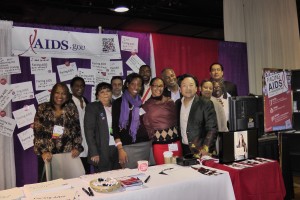New Media at the U.S. Conference on AIDS
Co-authored by Aisha Moore, Communications Director, HIV.gov

Each year at the United States Conference on AIDSExit Disclaimer (USCA) in Chicago, we notice more new media workshops, tweets, and people coming by our booth to share how they are using new media in response to HIV/AIDS. It’s exciting to see how far the HIV community has come, and how much more we can do to expand our reach. While there were plenty of examples in the exhibit hall, on Twitter and Facebook, and during the sessions and workshops, we were struck by the fact that this year the conversation was much more about strategically integrating social media into overall programs and communications planning.
Many of the new media sessions at USCA focused on working with and reaching specific populations. For example:
- The East Bay AIDS Center Downtown Youth ClinicExit Disclaimer from Oakland shared their experiences with integrating social media into HIV prevention programs through their hypechat website (read their blog post from earlier this year).
- Our colleagues from CDC NPIN hosted a roundtable about the social network community they created to share information and resources to commemorate 30 years of AIDSExit Disclaimer.
- Jefferey Erdman from the Illinois Pubic Health AssociationExit Disclaimer discussed the current state of new technologies that are being used by at-risk youth.
Several workshops focused on using online, mostly peer-generated, videos:
- The National Native American AIDS Prevention CenterExit Disclaimer hosted a workshop on using new media and video for National Native American HIV/AIDS Awareness Day (March 20).
- The Asian & Pacific Islander Wellness CenterExit Disclaimer presented their “SPOKEN SHORTS" videos created by and for young, Asian men who have sex with men. By having youth tell their own stories, they used technology to focus on positive behavior changes and the challenges of cultural and sexual stigma.
- The Native CHAT Program sponsors a film festExit Disclaimer for the teens to share their work with the community and receive awards. As one program stated, “we have a group of Steven Spielberg’s within the Native community that are sharing their stories through film.” Because the storytelling culture is strong in the Native community, these videos have proven effective in empowering these teens and revealing Native views related to sexual health.
- Janssen Therapeutics presented their YouTube video, The JourneyExit Disclaimer, that looked at the challenges faced by peer advocates at four AIDS service organizations around the country.
HIV.gov also hosted several social media activities:
- Jeremy Vanderlan and I (Michelle Samplin-Salgado) gave a presentation about mobile apps, the mobile web, and text messaging related to sexual health information. Not only did we share our own experiences about how HIV.gov is using mobile for HIV prevention and care, we were also inspired by the ideas and creativity from the participants. See the slides hereExit Disclaimer.
- We created a new media scavenger hunt to encourage people to use social media tools and will be developing an online version. Stay tuned!
- At the HIV.gov booth, we hosted our Facing AIDS online photo initiative for the fourth year. Facing AIDS continues to use new media to encourage people to share why they are Facing AIDS for World AIDS Day, December 1.
New media helps us virtually connect, but it’s conferences and meetings such as USCA that remind us how important those connections are. Thank you to NMACExit Disclaimer and all the participants at USCA who helped to make this conference another opportunity for us to learn from, share with, and connect with each other.